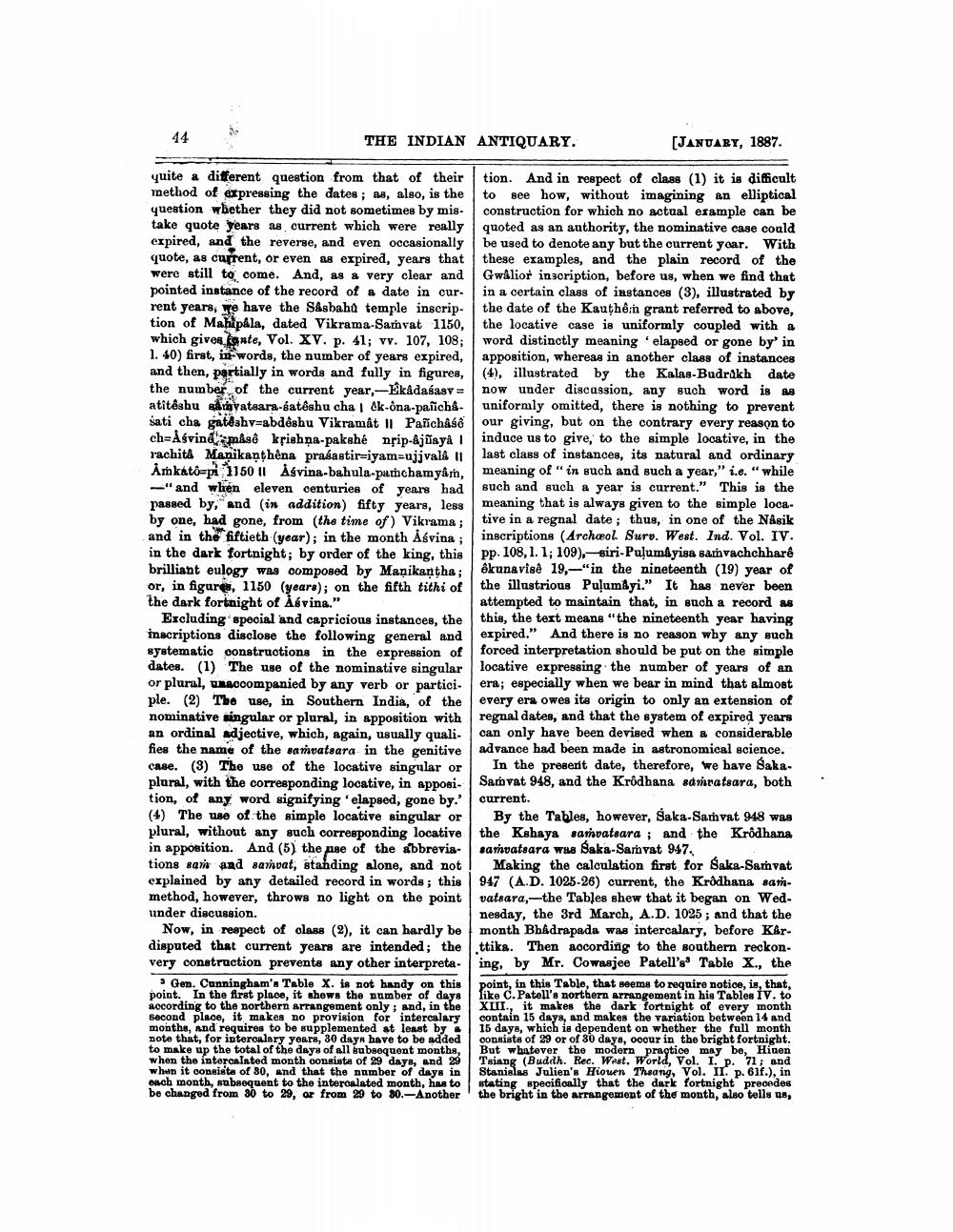________________
THE INDIAN ANTIQUARY.
[JANUARY, 1887.
quite a different question from that of their tion. And in respect of class (1) it is difficult method of expressing the dates; a, also, is the to see how, without imagining an elliptical question whether they did not sometimes by mis- construction for which no actual example can be take quote years as current which were really quoted as an authority, the nominative case could expired, and the reverse, and even occasionally be used to denote any but the current year. With quote, as current, or even as expired, years that these examples, and the plain record of the were still to come. And, as a very clear and Gwalior inscription, before us, when we find that pointed instance of the record of a date in cur. in a certain class of instances (3), illustrated by rent years, we have the S&sbahu temple inscrip- the date of the Kauthêm grant referred to above, tion of Mahipala, dated Vikrama-Samvat 1150, the locative case is uniformly coupled with a which gives fante, Vol. XV. p. 41; vv. 107, 108; word distinctly meaning elapsed or gone by'in 1. 40) first, in-words, the number of years expired, apposition, whereas in another class of instances and then, partially in words and fully in figures, (4), illustrated by the Kalas-Budrakh date the number of the current year,- kådaśasy = now under discussion, any such word is as atitéshu ahvatsara-satêshu cha | Ok-na-pasicha. | uniformly omitted, there is nothing to prevent sati cha gatëahv=abdêshu Vikramåt || Pafichåso our giving, but on the contrary every reason to ch=Agvindamise krishna-pakshe nsip-Ajraya ! induce us to give, to the simple locative, in the rachita Manikanthêna prasastir=iyam-ujjvald 11 last class of instances, its natural and ordinary Åmkatoap 1150 11 Ågvina-bahula-pathchamyarn, meaning of " in such and such a year," i.e. " while -"and when eleven centuries of years had such and such a year is current." This is the passed by," and in addition) fifty years, less meaning that is always given to the simple locaby one, had gone, from the time of ) Vikrama; tive in a regnal date ; thus, in one of the Nâsik and in the fiftieth (year); in the month Åsvina ; inscriptions (Archæol. Sury. West. Ind. Vol. IV. in the dark fortnight; by order of the king, this Pp. 108, 1. 1; 109).-siri-Pulum&yisa samvachchhare brilliant eulogy was composed by Manikantha;
@kuna vise 19,-"in the nineteenth (19) year of or, in figure, 1150 (years); on the fifth tithi of the illustrious Pulumáyi." It has never been the dark fortnight of Åsvina."
attempted to maintain that, in such a record as Excluding special and capricious instances, the this, the text means "the nineteenth year having inscriptions disclose the following general and expired." And there is no reason why any such systematic constructions in the expression of forced interpretation should be put on the simple dates. (1) The use of the nominative singular locative expressing the number of years of an or plurul, unaccompanied by any verb or partici. era; especially when we bear in mind that almost ple. (2) The use, in Southern India, of the every era owes its origin to only an extension of nominative singular or plural, in apposition with regnal dates, and that the system of expired years an ordinal adjective, which, again, usually quali. can only have been devised when a considerable fies the name of the saívatsara in the genitive advance had been made in astronomical science. case. (3) The use of the locative singular or In the present date, therefore, we have Saka. plural, with the corresponding locative, in apposi- Samvat 948, and the Krodhana sdnratsara, both tion, of any word signifying elapsed, gone by.' current. (4) The use of the simple locative singular or By the Tables, however, Saka-Samvat 948 was plural, without any such corresponding locative the Kshaya samvatsara ; and the Krôdhana in apposition. And (5) the pse of the abbrevia- | samvatsara was Saka-Samvat 947 tions saria and samvat, standing alone, and not Making the calculation first for Saka-Samvat explained by any detailed record in words; this 947 (A.D. 1025-26) current, the Krôdhana sanmethod, however, throws no light on the point vatsara, -the Tables shew that it began on Wed. under discussion.
nesday, the 3rd March, A.D. 1025; and that the Now, in respect of class (2), it can hardly be month Bhadrapada was intercalary, before Kar. disputed that current years are intended; the .ttika. Then according to the southern reckon. very construction prevents any other interpreta- ing, by Mr. Cowasjee Patell's' Table x., the
3 Gen. Cunningham'. Table X. is not handy on this point, in this Table, that seems to require notice, is, that, oint. In the first place, it shows the number of days like C. Patoll's northern Arrangement in his Tables IV. to nocording to the northern arrangement only; and, in the XIII., it makes the dark fortnight of every month second place, it makes no provision for intercalary contain 15 days, and makes the variation between 14 and months, and requires to be supplemented at least by # 15 days, which is dependent on whether the full month note that, for intercalary years, 30 days have to be added consists of 29 or of 30 days, occur in the bright fortnight. to make up the total of the days of all subsequent months, But whatever the modern practice may be. Hinen when the intercalated month consists of 29 days, and 29 Tsiang (Buddh. Rec. West. World, Vol. I. p. 71; and when it consists of 80, and that the number of days in Stanislas Julien's Hiouen Theang, Vol. II. p. 61f.), in ench month, subsequent to the intercalated month, has tostating specifically that the dark fortnight precedes be changed from 80 to 29, or from 20 to 80.-Another the bright in the arrangement of the month, also tells us,




